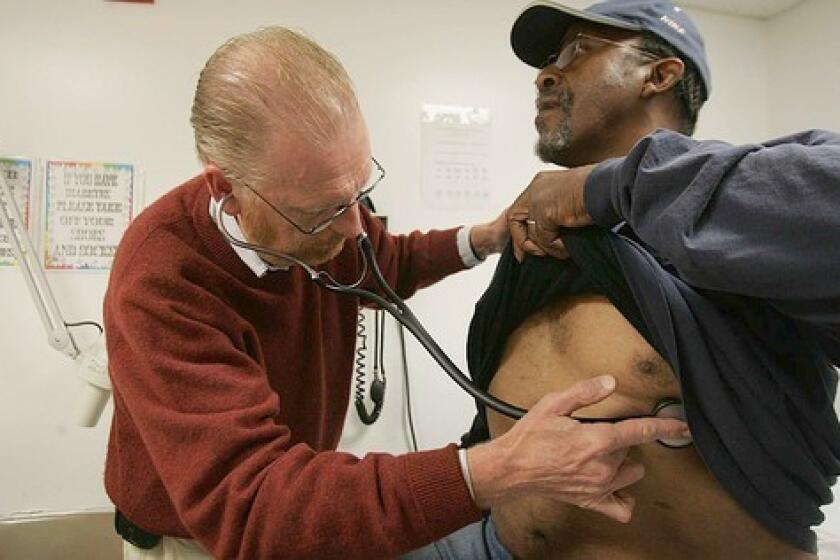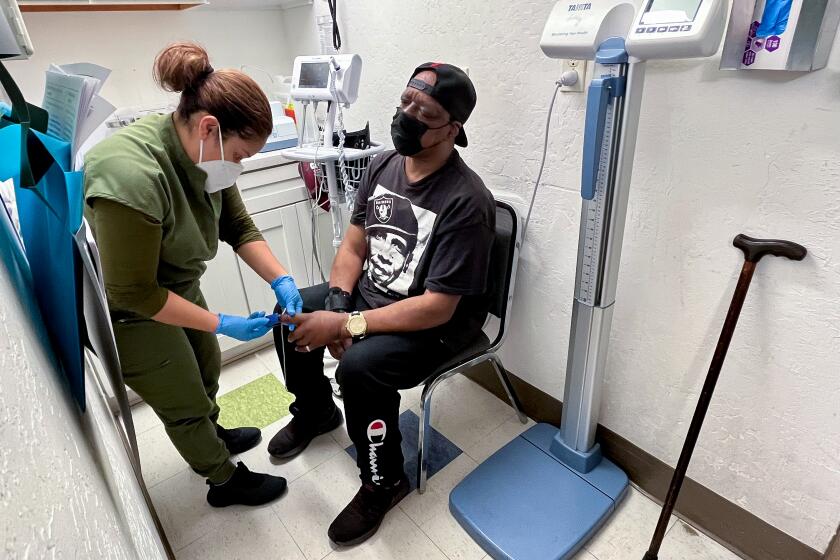California effort to confront implicit bias among doctors faces 1st Amendment challenge

- Share via
Los Angeles anesthesiologist Dr. Marilyn Singleton was outraged about a California requirement that every continuing medical education course include training in implicit bias — the ways in which physicians’ unconscious attitudes might contribute to racial and ethnic disparities in healthcare.
Singleton, who is Black and has practiced for 50 years, sees calling doctors out for implicit bias as divisive, and argues that the state cannot legally require her to teach the idea in her continuing education classes. She has sued the Medical Board of California, asserting a constitutional right not to teach something she doesn’t believe.
The way to address healthcare disparities is to target low-income people for better access to care, rather than “shaking your finger” at white doctors and crying “racist,” she said. “I find it an insult to my colleagues to imply that they won’t be a good doctor if a racially divergent patient is in front of them.”
The litigation is part of a national crusade by right-leaning advocacy and legal groups against diversity, equity and inclusion, or DEI, initiatives in healthcare. The resistance is inspired in part by last year’s U.S. Supreme Court ruling barring affirmative action in higher education.
The California lawsuit does not dispute the state’s authority to require implicit-bias training. It questions only whether the state can require all teachers to discuss implicit bias in their continuing medical education courses. The suit’s outcome, however, could influence obligatory implicit-bias training for all licensed professionals.
Medical and legal professionals in California would be required to take implicit bias training to address unconscious racism under a set of bills awaiting action by Gov. Gavin Newsom.
Leading the charge is the Pacific Legal Foundation, a Sacramento-based organization that describes itself as a “national public interest law firm that defends Americans from government overreach and abuse.” Its clients include the activist group Do No Harm, founded in 2022 to fight affirmative action in medicine. The two groups have also joined forces to sue the Louisiana medical board and the Tennessee podiatry board for reserving board seats exclusively for racial minorities.
In their complaint against the California Medical Board, Singleton and Do No Harm, along with Los Angeles ophthalmologist Dr. Azadeh Khatibi, argue that the implicit-bias training requirement violates the 1st Amendment rights of doctors who teach continuing medical education courses by requiring them to discuss how unconscious bias based on race, ethnicity, gender identity, sexual orientation, age, socioeconomic status or disability can alter treatment.
“It’s the government saying doctors must say things, and that’s not what our free nation stands for,” said Khatibi, who immigrated to the U.S. from Iran as a child. Unlike Singleton, Khatibi does believe implicit bias can unintentionally result in substandard care. But, she said, “on principle, I don’t believe in the government compelling speech.”
The lawsuit challenges the evidence of implicit bias in healthcare, saying there is no proof that efforts to reduce bias are effective. Interventions have thus far not demonstrated lasting effects, studies have found.
In December, U.S. District Judge Dale S. Fischer dismissed the suit but allowed the Pacific Legal Foundation to file an amended complaint. A hearing is scheduled for March 11 in federal court in Los Angeles.
The California State Assembly is preparing to vote on three bills to require mandatory training on implicit bias for law enforcement officers, medical professionals, judges and trial lawyers.
In enacting the training requirement, the California Legislature found that physicians’ biased attitudes unconsciously contribute to healthcare disparities. It also found that racial and ethnic disparities in healthcare outcomes are “remarkably consistent” across a range of illnesses and persist even after adjusting for socioeconomic differences, whether patients are insured and other factors influencing care.
Black women are three to four times as likely as white women to die of pregnancy-related causes, are often prescribed less pain medication than white patients with the same complaints, and are referred less frequently for advanced cardiovascular procedures, the Legislature found.
It also noted that women treated by female doctors were more likely to survive heart attacks than those treated by men. This month, the Legislature’s Black Caucus unveiled a bill requiring implicit-bias training for all maternal care providers in the state.
Dr. Khama Ennis, who teaches an implicit-bias class for Massachusetts doctors, sees only the best intentions in her fellow physicians. “But we’re also human,” she said in an interview. “And to not acknowledge that we are just as susceptible to bias as anybody else in any other field is unfair to patients.”
Ennis offered an example of her own bias in a training session. Preparing to treat a patient in a hospital emergency room, she noticed a Confederate flag tattoo on his forearm.
“As a Black woman, I had to have a quick chat with myself,” she said. “I needed to ensure that I provided the same standard of care for him that I would for anyone else.”
Ennis’ class meets the requirements of a Massachusetts law that physicians earn two hours of instruction in implicit bias to obtain or renew their licenses, as of 2022.
Does the blood of black people clot more readily than that of white people?
That same year, California began requiring that all accredited continuing medical education courses involving direct patient care include discussion of implicit bias. The state mandates 50 hours of continuing education every two years for doctors to maintain their licenses. Private institutions offer courses on an array of topics, and physicians generally teach them.
Teachers may tell students they do not believe implicit bias drives healthcare disparities, Fischer wrote in her December ruling. But the state, which licenses doctors, has the right to decide what must be included in the classes, the judge wrote.
Professionals who elect to teach courses “must communicate the information that the legislature requires medical practitioners to have,” the judge wrote. “When they do so, they do not speak for themselves, but for the state.”
Whether they speak for themselves or for the state is a pivotal question. While the 1st Amendment protects private citizens’ right to free speech, that protection does not extend to government speech. The content of public school curricula, for example, is the speech of state government, not the speech of teachers, parents or students, courts have said.
The Pacific Legal Foundation’s amended complaint aims to convince the judge that its clients teach as private citizens with 1st Amendment rights. If the judge again rules otherwise, lead attorney Caleb Trotter said, he plans to appeal the decision to the U.S. Court of Appeals for the 9th Circuit, and, if necessary, the Supreme Court.
“This is not government speech at all,” he said. “It’s private speech, and the 1st Amendment should apply.”
Inaccurate pulse oximeter readings are more common in Black patients than non-Black ones. It was a problem that could be ignored — until COVID-19 hit.
“Plaintiffs are plainly wrong,” lawyers for Rob Bonta, the state attorney general, responded in court papers. “There can be no dispute that the State shapes or controls the content of continuing medical education courses.”
The medical board declined to comment on the pending litigation.
From 2019 through July 2022, in addition to California and Massachusetts, four states enacted legislation requiring healthcare providers to be trained in implicit bias.
A landmark 2003 Institute of Medicine report, “Unequal Treatment,” found that limited access to care and other socioeconomic differences explain only part of racial and ethnic disparities in treatment outcomes. The expert panel concluded that clinicians’ prejudices could also contribute.
In the two decades since the report’s release, studies have documented that bias does influence clinical care and contribute to racial disparities, a 2022 report said.
But implicit-bias training might have no impact and might even worsen discriminatory care, the report found.
“There’s not really evidence that it works,” Khatibi said. “To me, addressing healthcare disparities is really important because lives are at stake. The question is, how do you want to achieve these ends?”
KFF Health News, formerly known as Kaiser Health News, is a national newsroom that produces in-depth journalism about health issues.










